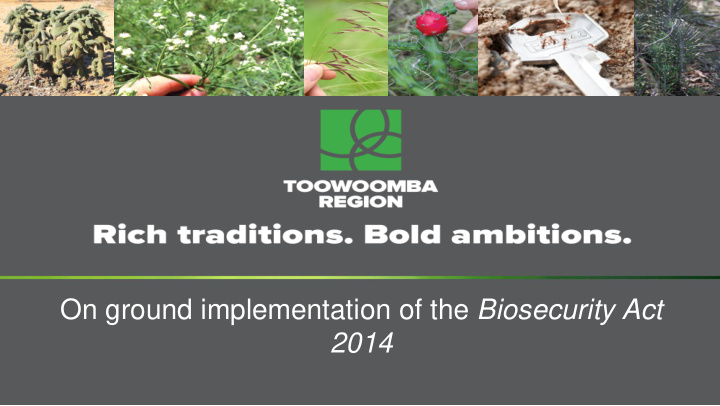



On ground implementation of the Biosecurity Act 2014
The Biosecurity Act 2014 (the Act) commenced on 1 July 2016, it ensures a consistent, modern, risk-based and less prescriptive approach to biosecurity in Queensland. The Act provides comprehensive biosecurity measures to safeguard our economy, industries, environment and lifestyle, from: • pests (e.g. wild dogs and weeds) • Diseases (e.g. foot-and-mouth disease) • Contaminants (e.g. lead on grazing land) The Act replaced the many separate pieces of legislation that were previously used to mange biosecurity. Decisions made under the Act will depend on the likelihood and consequences of the risk. This means risk can be managed more appropriately. Under the Act, the Biosecurity Regulation 2016 sets out how the Act is implemented and applied.
The Biosecurity Regulation 2016 The regulations prescribe ways in which a person's general biosecurity obligation can be met to prevent or minimise a biosecurity risk, and includes measures to prevent or control the spread of biosecurity matter, sets maximum acceptable levels of contaminants in carriers, and sets fees. The regulations were developed through public consultation, and engagement with affected industries.
Prohibited Matter This matter is not found in Queensland. If you find or believe this matter exists, you must report it immediately. mango pulp weevil karnal bunt of wheat ( Tilletia melon fly ( Bactrocera cucurbitae ) ( Sternochetus frigidus ) goat pox indica ) menangle virus heartwater ( Ehrlichia ruminantium ) foot and mouth getah virus peach fruit fly ( Bactrocera disease louping ill zonata ) Newcastle disease (virulent) epizootic lymphangitis ( Histoplasma aba aba jembrana disease capsulatum var. farciminosum ) lumpy skin disease tuberculosis (mammalian) Sumatra disease porcine enterovirus surra ( Trypanosoma evansi ) bacterium encephalomyelitis (Teschen) salmonellosis ( Salmonella abortus ovis ) ( Pseudomonas lime gall wasp ( Bruchophagus muli ) syzygii ) Restricted Matter Matter is found in Queensland. Action should be taken to limit its impact by reducing, controlling Reral Rusa Deer or containing it. Nandras thorn Harrisia cactus Hendra virus white tail disease gorse African Boxthorn Chinee Apple European fox Telegraph Weed Dingo Barbary Sheep Captain Cook Tree Singapore Daisy Bridal Creeper Silver-leaf Nightshade Lantanas
Categories Category 1 and 2. Have specific urgent reporting requirements. You must not take any action likely to exacerbate the biosecurity risk. You must take action likely to minimise the biosecurity risk posed by the matter. Category 1 includes red imported fire ants, electric ants, Asian honey bees, and certain animal diseases, aquatic diseases and pathogens. Biosecurity Queensland needs to be made aware of this restricted matter to take action to contain and eradicate it. You must report category 1 restricted matter to a Department of Agriculture and Fisheries inspector within 24 hours of becoming aware of its presence. $94 000 or 6 months – you choose? Category 2 restricted matter includes certain noxious fish, weeds and pest animals such as spotted gar and red-eared slider turtle. Biosecurity Queensland needs to be aware of this restricted matter to commence appropriate actions to reduce, control or contain the biosecurity matter. This restricted matter must be reported to an inspector within 24 hours of you becoming aware of its presence. Category 3 includes weeds, pest animals and noxious fish. You must not distribute this restricted matter. This means it must not be given as a gift, sold, traded or released into the environment unless the distribution or disposal is authorised in a regulation or under a permit. Deliberate human distribution or disposal contrary to the legislation is a key source of spread into other areas of the state. Category 4 includes specific weeds, pest animals and noxious fish such as the bitou bush, feral pig or giant cichlid. You must not move this restricted matter to ensure that it does not spread into other areas of the state. $65 000 Category 5 includes weeds, pest animals and noxious fish such as Mexican feather grass, rabbits and carp. You must not possess or keep this restricted matter under your control. These pests have a high risk of negatively impacting on the environment. You may only keep this restricted matter under a permit of the Biosecurity Act 2014 or another Act. Category 6 includes invasive animals such as feral deer, foxes, rabbits and wild dogs and noxious fish such as carp, gambusia and tilapia. You must not feed this category of restricted matter. Feeding this restricted matter may cause their numbers to increase and negatively impact the economy or the environment. Feeding for the purpose of preparing for or undertaking a control program is exempted. Category 7 includes noxious fish such as carp and tilapia. If you have these noxious fish in your possession you must kill the restricted matter and dispose of the carcass by burying the carcass (no parts removed) in the ground above the high tide water mark or placing it in a waste disposal receptacle. $65 000
Better Partnerships NRM-LG Funding Produce a science based risk assessment tool for IBM which will: • Be suitable for use by planning authorities and individual landholders alike in assessing biosecurity risk • Assist all users to apply common risk assessment methods to IBM • Be suitable for use by both experienced and inexperienced persons. Produce a template for a Strategic Invasive Biosecurity Matter Management Plan.
Under the BA, biosecurity management plan development has been streamlined. The requirements for Ministerial approval, the planning processes and the term of a plan have been removed.
Infrastructure Services Group • Construction and Maintenance • Transport and Drainage Planning • Project Services • Plant and Fleet • Business Support
Clean downs • Blowers or washing • Washdown schedule • Documentation
Pest and Weed data • Treatment areas mapped • Consideration of data in the planning process
Slashing
Maintenance Grading
Construction projects
Landscaping • Fire Ant Carriers • Weed Seeds • Mulch to be
Education • Informed decisions • Risk Matrix • Understanding of activity
Opportunities • Technology • Eradication • Public perception
Recommend
More recommend